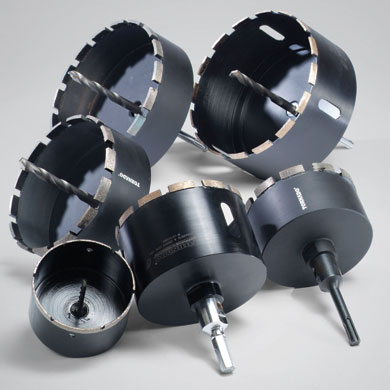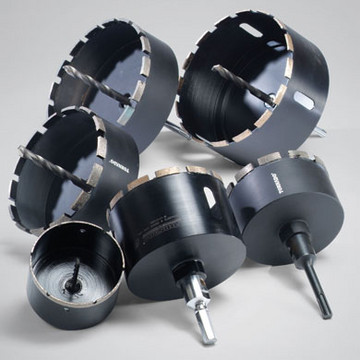
Holesaw Instructions
1.Mark out location for the required penetration.
2.Pre-drill a 12mm pilot hole using a masonry drill bit. (Figure 2)
3.Assemble the components for the holesaw. The pilot drill is a taper lock style and only requires to be knocked into the arbour to secure it. Use the provided drift key to remove the pilot drill when required.
4.Turn OFF hammer function. Only drilling action is required. The use of the hammer setting will “blow out” the polymer concrete being cut, and damage the holesaw.
5.Keeping the drill level, use the speed of the drill to do the cutting. Avoid using excess pressure. (Figure 3)
6.When the hole is 1/3 deep make small circular motions with the drill. This allows dust to escape easier and can aid in the elimination of jamming the bit in the hole. (Figure 4)
7.The holesaw range has been designed to drill polymer concrete dry. However it is necessary to cool the diamond cutting edge of the holesaw on a regular basis. For every 1.5 to 2 minutes of drilling, rinse and cool the holesaw in a shallow container of water. This will extend the life of the holesaw; keep the holesaw cutting at a faster rate and will stop the diamonds from ‘glazing’, which simply means they stop biting into the polymer concrete. Remember to shake off excess water before resuming to drill. (Figure 5)
8.Depending on the size of the holesaw used, penetrations should take between 45 seconds and 3 minutes. This also depends on the wattage and rpm’s of the drill being used. Rpm’s should be started on a slower speed to begin with, building up as you go. The speed can be always be increased as required. (Figure 6)
9.If the holesaws performance starts to slow over time, it may be that new diamonds need to be exposed and some of the alloy encasing those diamonds needs to be removed. To do this, drill a hole into some waste sandstone, limestone or concrete with sand added to the hole. Use water to irrigate as you drill. These materials are very abrasive and will wear away the old fatigued diamonds and alloy and expose new diamond cutting surfaces. 1 to 4 minutes should be ample time to re-fresh a holesaw.
ACO offers a range of holesaws to facilitate this operation.
